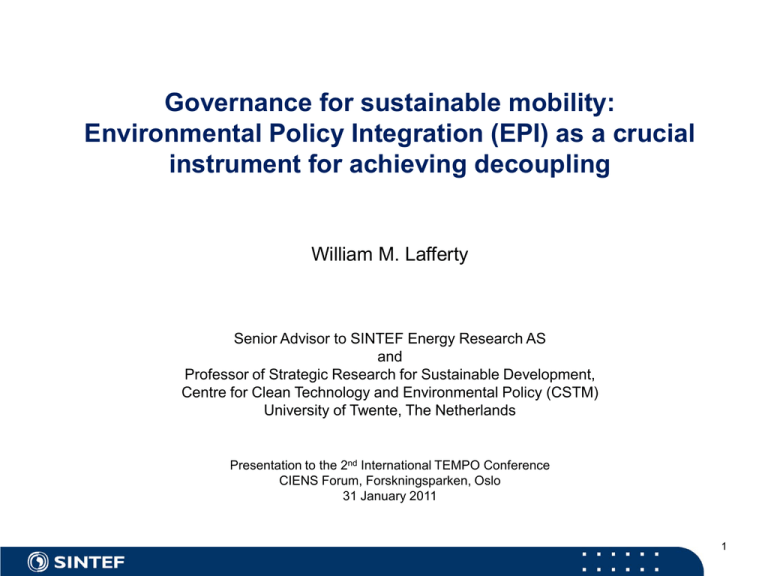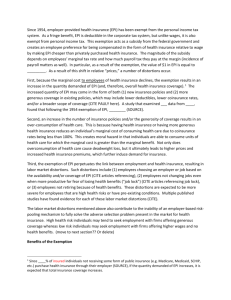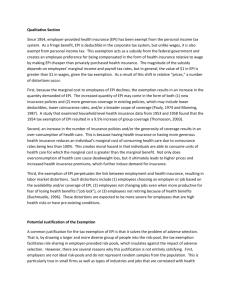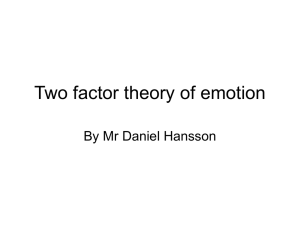Environmental Policy Integration
advertisement

Governance for sustainable mobility: Environmental Policy Integration (EPI) as a crucial instrument for achieving decoupling William M. Lafferty Senior Advisor to SINTEF Energy Research AS and Professor of Strategic Research for Sustainable Development, Centre for Clean Technology and Environmental Policy (CSTM) University of Twente, The Netherlands Presentation to the 2nd International TEMPO Conference CIENS Forum, Forskningsparken, Oslo 31 January 2011 1 A Norwegian “Prologue” to the conference theme: “Policy Change for Sustainable Transport” Highest consumption of petroleum since 1999 Norway’s consumption of petroleum in 2010 was the highest since 1999. According to the Bureau of Statistics [consumption] was 5 percent higher than for 2009. The use of diesel, heating oil and jet fuel all showed strong increases. Diesel outsold gasoline by two-to-one last year. . . [ending the year at approximately $8.20 per gallon] The sale of diesel increased by 10 percent; the sale of jet fuel by 10 percent; and the sale of heating oil by 21 percent. Teknisk Ukeblad (No. 2/2011) 2 Environmental Policy Integration (EPI): The concept The “name defines the game”: “Environmental Policy Integration” is semantically indicative of a process that involves the integration (conjoining, completing, making whole) of environmental/ecological concerns (values, goals, policy tasks) into other public policies The designated activity thus involves: a governing (steering) process; designed to produce amended (“integrated”) sectoral policies; the consequences of which are environmentally benign. The term has been thoroughly elaborated within two parallel “discourses”: A “political discourse”: Related to commitments by national governments to implement international and regional agreements (UN and EU) which aim to promote sustainable development. An “academic discourse”: Devoted to clarification of both the normative and empirical-analytic nature of the concept 3 The “mandate” for EPI within the political discourse: The Brundtland Report: “The ability to choose policy paths that are sustainable requires that the ecological dimensions of policy be considered at the same time as the economic, trade, energy, agricultural, industrial, and other dimensions – on the same agendas and in the same national and international institutions. That is the chief institutional challenge of the 1990s.” (WCED 1987: 313) Article 11 of the basic “Principles” of the Consolidated Treaty on the Functioning of the European Union: “Environmental protection requirements must be integrated into the definition and implementation of the Community policies and activities, in particular with a view to promoting sustainable development.” 4 Clarification of EPI within the academic discourse: Liberatore (1997: 107): “The relevance for moving towards sustainable development is straightforward: if environmental factors are not taken into consideration in the formulation and implementation of the policies that regulate economic activities and other forms of social organization, a new model of development that can be environmentally and socially sustainable in the long term cannot be achieved”. Lenschow (2002: 6-7): “ . . . EPI represents a first-order operational principle to implement and institutionalize the idea of sustainable development”. “. . . It implies that policy makers in non-environmental sectors recognize the environmental repercussions of their decisions and adjust them when they undermine sustainable development. . . . In the absence of clearly defined policy goals, indicators and timetables, however, there remains ample room for sectoral policy makers to evade such substantive environmental responsibilities. The integration process currently faces the challenge of ensuring that substance follows from procedure”. 5 The core EPI problematic: resolving trade-offs to achieve SD Social-welfare concerns Economic concerns Economy< >welfare trade-offs Economy Welfare Ecology Welfare< >ecology trade-offs Economy< >ecology trade-offs Ecological concerns “Integrated”, “balanced”, “coherent” outcomes for sustainable development 6 Promoting EPI in the transport sector: decoupling and recoupling within the DPSIR framework Recoupling Environmental Policy Integration (EPI) Governing “process” Decoupling Substantive SD “outcomes” 7 Evaluating EPI as sectoral policy: The EEA Framework Source: EEA (2005a): 10 8 The original “academic” model of EPI: Nilsson and Persson (2003) Background variables Independent variables Dependent variable Problem character Political will Assessment processes Policy-making rules EPI Policy outcomes International policy context 9 Supplementing the “academic-model”: The ProSus approach Background variables Problem character Political will Independent variables Dependent variable Path dependency: contextual analysis (a vital “conditioning” variable)( Assessment processes EPI Policy-making rules International policy context Priority principles: for resolving trade-offs (the crucial issue of “firstorder priority” – “trump”) Policy outcomes Benchmarks: for evaluating EPI governing mechanisms (horizontally/vertically) 10 In sum: The analysis and application of EPI within the political and academic discourses is thoroughly documented (Key references attached) The European Commission has sponsored a separate research network for further clarification and development of the concept – EPIGOV: http://ecologic.eu/projekte/epigov/ The European Environment Agency (EEA) continues to focus EPI as a key process for promoting and evaluating sustainable development: http://www.eea.europa.eu/highlights/Ann1120649962 There are numerous steering instruments available for promoting decoupling through EPI: guidelines for strategic plans and action plans; empirically derived benchmarks for specific governing bodies, decision-making procedures and rules; advisory bodies and “consensus conferences” for resolving knowledge claims and applying the “precautionary principle” indicators for decoupling and eco-efficiency, etc, etc. 11 Yet ........ The record for achieving EPI-related governance for decoupling and sustainable development is marginal, fragmented and faltering Marginal in terms of both: (1) the number of political domains (national, regional, local) where it has been recognized and introduced; and (2) the relative impact – “transformative potential” – of the sectors involved Fragmented in terms of a general lack of horizontal-vertical policy coordination, monitoring and revision And, most recently, faltering and in outright reversal due to: The undermining of the Rio Consensus on international soft-law implementation of sustainable development The take-off – and subsequent crash – of the global climate-change agenda A general weakening (in the media) of the scientific arguments for action Major financial, fiscal and economic strain in the Western economies An increasing dysfunctionality in the Western model of “competitive democracy” These problems are serious indeed: they require strong remedial action at the international and national levels – action that is not likely to materialize in the near future 12 What to do? Press forward a discourse on the need for “ecological democratization” – new principles, institutions and procedures for “post-competitive”, “post-polyarchal” democracy Actively propagate an ethics of stewardship and generational responsibility, as a necessary alternative to open-ended gratification Build on the very powerful positive forces emerging in green technology, green investment and market phase-in Focus on regional identities and innovation within ecological boundaries, as an alternative to the “politics of allocation” within outmoded politicaladministrative domains Exploit new initiatives for adapting to climate change to promote community-based ecological security Openly acknowledge that decentralized, regional initiatives are not a sustainable end in themselves; but constitute a necessary stop-gap means for reviving – and revising – the global development goals of Our Common Future 13 The relevance of transport? A crucial sector for EPI and decoupling in general – and a particularly crucial sector for a transition to ecological democracy on a local-regional basis A policy sector with an exceptionally high number of economic, social and environmental trade-offs An area of intense political scrutiny and debate, with significant impacts on personal-familial identity, life choices and community development An area with major negative impacts: climate change, local air and noise pollution, illness and accidental mortality, natural and aesthetic destruction, declining land values, environmental injustice, etc, etc An area that is per definition regional in function and scope; and ecological in terms of interdependent impacts An SD policy area with exceptional possibilities for exploiting green technology and innovation in all aspects of “sustainable mobility” In short: an ideal arena for focusing the crucial “politics of trade-off and adaptive transition” necessary for realizing a carbon-neutral community 14 The challenge for research networks like TEMPO?: Continue to heighten the acute relevance of transport policy within the overall applied-science initiative for sustainable development Actively work for a more effective, problem-based integration of the social sciences into the design and execution of research projects Openly promulgate the relevance of Article 11 of the Treaty of the European Union for transport research and policy Increase resource allocations to develop improved methods of scientific dissemination, communication and policy integration. In Marshall McLuhan’s well-known phrase: “The medium is the message” At present, issues of mobility and transport constitute a vital “medium” for resolving trade-offs and achieving decoupling It is up to strategic research networks like TEMPO to analytically transpose this medium into a scientifically based “message” for sustainable mobility Good luck! And may the force (of EPI) be with you! 15 References in presentation (1): EEA (2005a). Environmental Policy Integration in Europe: State of Play and an Evaluative Framework, Technical Report, No 2/2005, Copenhagen: European Environment Agency. EEA (2005b). Environmental Policy Integration in Europe: Administrative Culture and Practices, Technical Report, No 5/2005, Copenhagen: European Environment Agency. Goria A., A. Sgobbi and I. von Homeyer (eds) (2010): Governance for the Environment. A Comparative Analysis of Environmental Policy Integration, Cheltenham UK: Edward Elgar. Jordan, A. J. and A. Lenschow (2008). Innovation in Environmental Policy? Integrating the Environment for Sustainability. Cheltenham UK: Edward Elgar. Knudsen, J. K. (2009). Environmental Policy Integration and Energy: Conceptual Clarification and Comparative Analysis of Standards and Mechanisms. Doctoral dissertation, University of Twente, Enschede, Netherland. Lafferty, W.M. (2000). “Democracy and ecological rationality: New trials for an old ceremony”, In Guy Lachapelle and John Trent (eds), Globalization, Governance and Identity: The Emergence of New Partnerships, Montreal: Montreal University Press, 2000, pp. 39-65 Lafferty, William M. (2004): “From environmental protection to sustainable development: The challenge of decoupling through sectoral integration” in Lafferty, William M. (ed) Governance for Sustainable Development: The Challenge of Adapting Form to Function. Cheltenhem UK: Edward Elgar publ. Lafferty, William M. and Eivind Hovden (2002): “Environmental Policy Integration: Towards an Analytical Framework”. ProSus Report No. 7/02. Oslo: ProSus, University of Oslo Lafferty W.M.. and J. Knudsen (forthcoming),: ‘The issue of ‘balance’ and trade-offs in environmental policy integration: How will we know EPI when we see it?”, in von Homeyer et al. (eds) The Promise and Practice of Environmental Policy Integration. A Multi-Level Governance Perspective. Cheltenham UK: Edward Elgar Lafferty William M., Audun Ruud and Olav Mosvold Larsen (2004): “Environmental Policy Integration: How will we recognize it when we see it? The Case of Green Innovation Policy in Norway” ProSus Working Paper 3/04. References in presentation (2): Lafferty William M., Audun Ruud and Olav Mosvold Larsen (2004): “Environmental Policy Integration: How will we recognize it when we see it? The Case of Green Innovation Policy in Norway” ProSus Working Paper 3/04. Oslo: ProSus, University of Oslo Lenschow, Andrea (2002a) Environmental Policy Integration. Greening sectoral policies in Europe. London: Earthscan Lenschow (2002b) “’Greening’ of the European Union – are there lessons to be learned for international environmental policy?” Global Environmental Change Vol 12 pp 201-245. Liberatore, A. (1997): “The integration of sustainable development objectives into EU policy-making: Barriers and prospects” in Baker, Susan, Maria Kousis, Dick Richardson and Stephen Young (eds) The politics of sustainable development: Theory, policy and practice within the European Union. London: Routledge Nilsson, M. and K. Eckerberg (eds) (2009): Environmental Policy Integration in Practice. London: Earthscan Ltd. Nilsson M., M. Pallemaerts and I. von Homeyer (2009), ‘International regimes and environmental policy integration’ Special issue of International Environmental Agreements: Politics, Law and Economics, 9 (4) Nilsson, M. and Å. Persson (2004): “Framework for Analysing Environmental Policy Integration” in Journal of Environmental Policy and Planning Vol 5, No. 4, December 2003, p. 333-359. Carfax Publishing Persson, Åsa (2004): Environmental Policy Integration: An Introduction. PINTS – Policy Integration for Sustainability. Background Paper. ISBN: 91 975237 1 2. Stockholm: Stockholm Environment Institute – SEI. Wilkinson, David (1997): “Towards Sustainability in the European Union? Steps within the European Commission towards Integrating the Environment into Other European Union Policy Sectors” in Environmental Politics 6(1): 154-173 Institutional/procedural benchmarks for vertical policy integration: The responsibility of ministries Scoping reports of sectorial activity identifying major environmental impacts associated with key actors and processes Sectoral forums for dialogue and consultation with relevant stakeholders and affected citizens Sectoral strategies for change, with basic principles, goals, targets and timetables Sectoral action plans with specified tactics for achieving goals with targetgroup related policy instruments Green budgets for highlighting, prioritizing and implementing action plans Monitoring programs for evaluating implementation and revising strategies and action plans 18 Institutional/procedural benchmarks for horizontal policy integration The responsibility of governments/cabinets A “constitutive” mandate providing provisions for the special status of environmental/sustainable-development rights and goals. An over-arching strategy for the sectoral domain, with clearly enunciated goals and operational principles, and a political mandate with direct backing from the chief executive authority. A national action plan with both over-arching and sectoral targets, indicators and timetables. A responsible executive body with designated responsibility (and powers) for the overall coordination, implementation and supervision of the integration process. A communications plan stipulating sectoral responsibility for achieving overarching goals, and outlining how intra-sectoral communications are to be structured and made transparent. An independent auditor with responsibility for monitoring and assessing implementation at both governmental and sectoral levels, and for proposing revisions in subsequent generations of strategies and action plans A board of petition and redress for resolving conflicts of interest between environmental and other societal objectives, interests and actors 19











